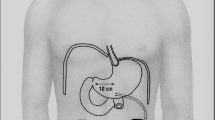Abstract
Background
Gastric electrical stimulation (GES) is a low-morbidity treatment option that may be effective for refractory symptoms in patients with gastroparesis of diabetic or idiopathic etiology. During surgery to initiate GES, two electrodes are tunneled in the gastric antrum in a precise location. If these electrodes pass through the mucosa and into the gastric lumen (determined by endoscopy) they must be repositioned, often multiple times. During this procedure, extensive suturing to anchor the electrodes is necessary once properly placed. Robotic surgical systems may provide surgeons with several technical and ergonomic advantages during this procedure when compared with a standard laparoscopic approach.
Methods
Over a 26-month period, 22 GES systems were implanted. The initial procedures were performed laparoscopically. After the first 15 laparoscopic cases, a technique for robotically implanting leads was developed and employed for the remainder of the series. Demographics, operative time, and endoscopically confirmed electrode mucosal perforations were quantified and compared based on operative approach.
Results
Patients were similar demographically. Total operative time did not differ based on technique (152 ± 40 min laparoscopic versus 158 ± 38 min robotic placement; p = 0.6). Mucosal perforations on first attempt at electrode placement occurred more frequently with the laparoscopic than with the robotic technique (15/30 laparoscopic versus 1/14 robotic; p = 0.006). There were no procedure-related complications.
Conclusions
The robotic approach to GES electrode implantation is feasible and safe. Compared with standard laparoscopic techniques, the accurate insertion and anchoring of these leads can be accomplished more efficiently and comfortably using robotic techniques. Whether robotic GES electrode placement will result in significant clinical advantages for patients will require long-term follow-up.

Similar content being viewed by others
References
Abell TR, McCallum RW, Hocking M, Koch K, Abrahamsson H, Leblanc I, Lindberg G, Konturek J, Nowak T, Quigley EM, Tougas G, Starkebaum W (2003) Gastric electrical stimulation for medically refractory gastroparesis. Gastroenterology 125:421–428
Anand C, Al-Juburi A, Familoni B, Rashed H, Cutts T, Abidi N, Johnson WD, Minocha A, Abell TL (2007) Gastric electrical stimulation is safe and effective: a long-term study in patients with drug-refractory gastroparesis in three regional centers. Digestion 75:83–89
Eagon JC, Kelly KA (1993) Effects of gastric pacing on canine gastric motility and emptying. Am J Physiol 265:767–774
Miedema BW, Sarr MG, Kelly KA (1992) Pacing the human stomach. Surgery; 111:143–150
de Csepel J, Goldfarb B, Shapsis A, Goff S, Gabriel N, Eng HM (2006) Electrical stimulation for gastroparesis: gastric motility restored. Surg Endosc 20:302–306
Al-Juburi A, Granger S, Barnes J, Voeller G, Beech D, Amiri H, Abell TL (2005) Laparoscopy shortens length of stay in patients with gastric electrical stimulators. JSLS 9(3):305–310
Keus F, de Jong JA, Gooszen HG, van Laarhoven CJ (2006) Laparoscopic versus open cholecystectomy for patients with symptomatic cholecystolithiasis. Cochrane Database Syst Rev 4:CD006231
Memon MA, Cooper NJ, Memon B, Memon ML, Abrams KR (2003) Meta-analysis of randomized clinical trials comparing open and laparoscopic inguinal hernia repair. Br J Surg 90(12):1479–1492
Stefanidis D, Korndorffer JR, Markley S, Sierra R, Heniford BT, Scott DJ (2007) Closing the gap in operative performance between novices and experts: does harder mean better for laparoscopic simulator training? J Am Coll Surg 205(2):307–313
Liu RC, Sabnis AA, Chand B (2007) Erosion of gastric electrical stimulator electrodes: evaluation, management, and laparoscopic techniques. Surg Laparosc Endosc Percutan Tech 17(5):438–441
Becker JC, Dietl KH, Konturek JW, Domschke W, Pohle T (2004) Gastric wall perforation: a rare complication of gastric electrical stimulation. Gastrointest Endosc 59:584–586
Abu-Abeid S, Keidar A, Gavert N, Blanc A, Szold A (2003) The clinical spectrum of band erosion following laparoscopic adjustable silicone gastric banding for morbid obesity. Surg Endosc 17:861–863
Suter M, Giusti V, Heraief E, Calmes JM (2004) Band erosion after laparoscopic gastric banding: occurrence and results after conversion to Roux en-Y gastric bypass. Obes Surg 14:381–386
Lin Z, Sarosiek I, Forster J, McCallum RW (2006) Symptom responses, long-term outcomes and adverse events beyond 3 years of high-frequency gastric electrical stimulation for gastroparesis. Neurogastroenterol Motil 18:18–27
Abell T, Van Cutsem E, Abrahamsson H, Huizinga JD, Konturek JW, Galmiche JP, VoelIer G, Filez L, Everts B, Waterfall WE, Domschke W, Bruley des Varannes S, Familoni BO, Bourgeois IM, Janssens J, Tougas G (2002) Gastric electrical stimulation in intractable symptomatic gastroparesis. Digestion 66:204–212
Abell T, McCallum R, Hocking M, Koch K, Abrahamsson H, Leblanc I, Lindberg G, Konturek J, Nowak T, Quigley EM, Tougas G, Starkebaum W (2003) Gastric electrical stimulation for medically refractory gastroparesis. Gastroenterology 125:421–428
Yohannes P, Rotariu P, Pinto P, Smith AD, Lee BR (2002) Comparison of robotic versus laparoscopic skills: is there a difference in the learning curve? Urology 60(1):39–45
Chang L, Satava RM, Pellegrini CA, Sinanan MN (2003) Robotic surgery: identifying the learning curve through objective measurement of skill. Surg Endosc 17(11):1744–1748
Eemskerk J, van Gemert WG, de Vries J, Greve J, Bouvy ND (2007) Learning curves of robot-assisted laparoscopic surgery compared with conventional laparoscopic surgery: an experimental study evaluating skill acquisition of robot-assisted laparoscopic tasks compared with conventional laparoscopic tasks in inexperienced users. Surg Laparosc Endosc Percutan Tech 17(3):171–174
Mohr CJ, Nadzam GS, Alami RS, Sanchez BR, Curet MJ (2006) Totally robotic laparoscopic Roux en-Y Gastric bypass: results from 75 patients. Obes Surg 16(6):690–696
Gofrit ON, Mikahail AA, Zorn KC, Zagaja GP, Steinberg GD, Shalhav AL (2008) Surgeons’ perceptions and injuries during and after urologic laparoscopic surgery. Urology 71(3):404–407
Berguer R, Smith W (2006) An ergonomic comparison of robotic and laparoscopic technique: the influence of surgeon experience and task complexity. J Surg Res 134(1):87–92
Author information
Authors and Affiliations
Corresponding author
Rights and permissions
About this article
Cite this article
Gould, J.C., Dholakia, C. Robotic implantation of gastric electrical stimulation electrodes for gastroparesis. Surg Endosc 23, 508–512 (2009). https://doi.org/10.1007/s00464-008-0063-1
Received:
Revised:
Accepted:
Published:
Issue Date:
DOI: https://doi.org/10.1007/s00464-008-0063-1




